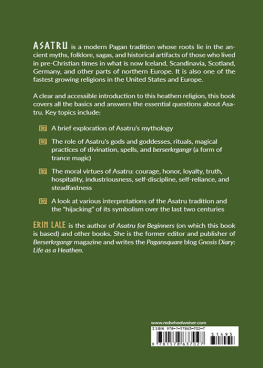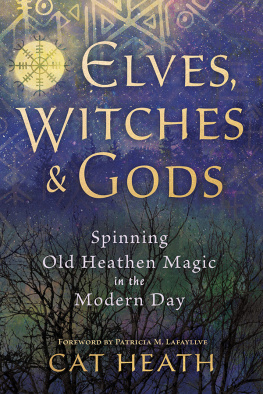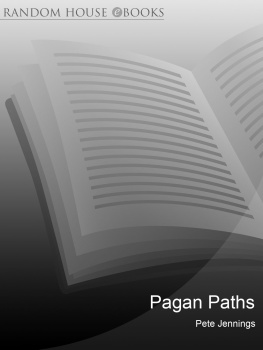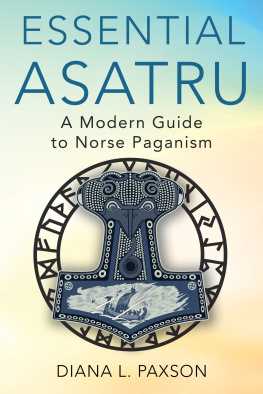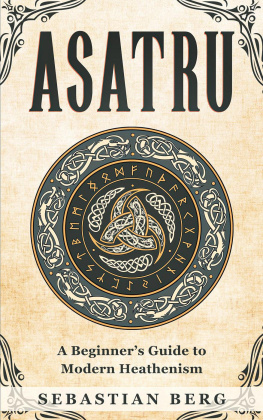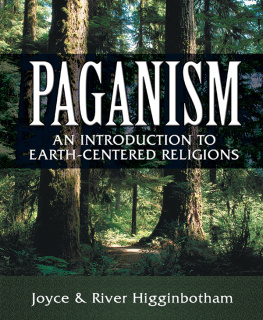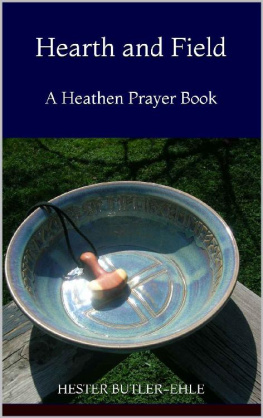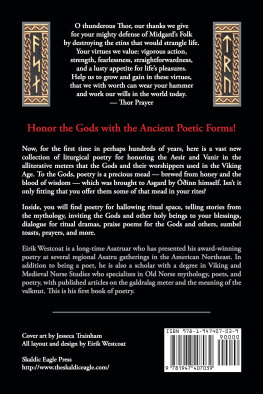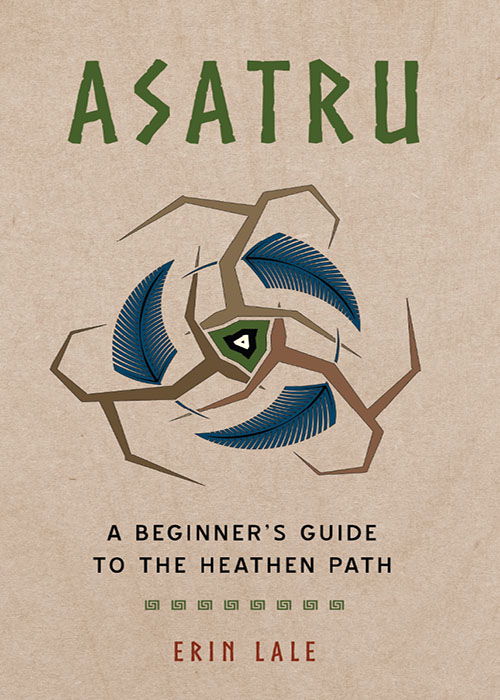
ASATRU
A BEGINNER'S GUIDE TO THE HEATHEN PATH
ASATRU
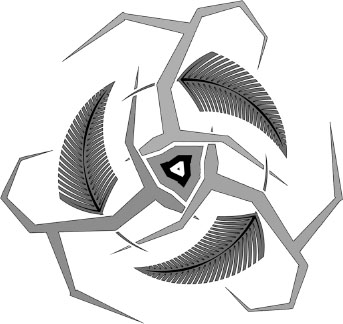
A BEGINNER'S GUIDE TO THE HEATHEN PATH

ERIN LALE

This edition first published in 2020 by Weiser Books, an imprint of
Red Wheel/Weiser, LLC
With offices at:
65 Parker Street, Suite 7
Newburyport, MA 01950
www.redwheelweiser.com
Copyright 2020 by Erin Lale
All rights reserved. No part of this publication may be reproduced or
transmitted in any form or by any means, electronic or mechanical,
including photocopying, recording, or by any information storage
and retrieval system, without permission in writing from
Red Wheel/Weiser, LLC. Reviewers may quote brief passages.
ISBN: 978-1-57863-702-7
Library of Congress Cataloging-in-Publication Data
available upon request
Cover design by Kathryn Sky-Peck
Interior by Steve Amarillo / Urban Design LLC
Typeset in Adobe Caslon Pro and DIN Pro
Printed in the United States of America
IBI
10 9 8 7 6 5 4 3 2 1
www.redwheelweiser.com/newsletter
ACKNOWLEDGMENTS
Thank you to all those who encouraged me to
write an updated version of Asatru for Beginners.
Thanks to the members of my group, the Asatru
Facebook Forum, and to all my loyal readers.
CONTENTS
INTRODUCTION
Asatru is a heathen religion. A heathen is a pagan whose faith originated on the heath, that is, Germany, Iceland, Scandinavia, Scandinavian-influenced Scotland, and other parts of Northern Europe. The word heathen is Scots dialect, derived from Gothic, a Germanic language. The Rhine River, which served as the border between the Roman Empire and Germania, is the dividing line between what is the heath and what is not.
WHAT IS HEATHENRY?
There are other heathen religions, such as Theod, the Anglo-Saxon religion; Forn Sed and Forn Sidr, European variants of heathenry; Odinism, which has an English version and an American version; and Urglaawe, the Pennsylvania Deitsch tradition. Some heathens consider religions based on other European cultures to be sister religions, although they have different gods. The Celtic religion and Druidic faith centered in Ireland, Scotland, and parts of France is sometimes included as a sister religion. Some people include other traditions under the umbrella of sister religions as well, such as Slavic traditions.
Although many heathens do not consider themselves pagan, heathendom fits under the broad definition of a pagan as one who practices any of the non-Abrahamic religions. The three main religions of Abraham are Christianity, Judaism, and Islam. Most of the world's tribal religions are pagan in the broad sense. Many modern reconstructed religions, such as Asatru, and newly invented religions, such as the Church of All Worlds, are also pagan in a narrower sense of a new or reconstructed religion based on an older non-Christian tradition or body of knowledge. Only reconstructed and newly invented religions usually identify as pagan; religions with a continuous tradition, such as Hinduism, generally do not identify under the pagan umbrella. This is the reason some heathens do not consider heathenry to be pagan. Whereas outside observers consider heathenry to be a new religious movement, many heathens perceive heathenry to be a group of ethnic religions.
A group of people actively created Asatru out of the materials available from literature, archeology, and other scholarship, and continuous folk traditions that coexisted with Christianity after the age of conversion (that is, the time period during which countries in northern Europe officially became Christian countries). Asatru is not an unbroken tradition like Hinduism. Scholars define Asatru as a new religious movement, but they also define Asatru as a folk religion. A folk religion does not have a religious authority that decides what is and is not part of the religion. Rather, the customs, canon, beliefs, and practices of a folk religion are collectively decided by those who practice it. Asatru fits that definition. There is no Asa-Pope.
Some heathens don't consider heathenry to be pagan because generic paganism is synonymous with Wicca, whose practitioners call themselves witches. Most Asatruars do not identify as witches, and Asatru is not a form of witchcraft. There are magical traditions within heathenry and Asatru, but not all Asatruars practice magic.
WHAT IS ASATRU?
The word Asatru is pronounced with the stress on the first syllable. Pronounce the A as you would pronounce the Au in Austria. If you are from the United States, you probably say AH-suh-tru and AH-stree-uh. If you are from Iceland, you probably say OW-suh-tru and OW-stree-uh. Continental Europeans are split between the two.
Many Asatruars consider Asatru to be a nature religion. In addition to the gods, many of whom have functions and spheres of influence in nature, we also honor the landvttir, the land spirits. Some Asatruars see the gods as personifications of nature. Other Asatruars see nature as a personification of the divine.
Some Asatruars are polytheist and believe the named gods are all separate entities. Other Asatruars are pantheists and believe all the goddesses ultimately form one Great Goddess. And there are people in Asatru who fall in the middle, for example, they see Odin and his brothers as a trinity and yet different from each other, but see the other gods as separate from them.
As I mentioned previously, Asatru is a reconstructed religion. Rebuilding the elder faith continues through scholarship of literature and linguistics, anthropology and archeology, the study of fairy tales and folk customs, and the experiences of modern Asatruars. However, many current customs are holdovers from heathen times. Folk customs, fairy tales, and even many nominally Christian celebrations have heathen roots.
Asatru is a religion of action, not faith. To be a good Asatruar one must do specific things, which include participation in specific rituals, but one does not have to believe. The idea of accepting deity into one's heart to be saved is a Christian concept that is not part of heathenry. Within Asatru, there are those who believe, those who do not believe, and those who do not need faith because they have personal religious experiences and relationships with the gods and other beings. You can regard the gods as archetypes if you choose, as long as you act honorably. Acting honorably includes respecting other heathens who may be in another group and believing that doing heathenry differently than you does not mean they are doing it wrong.
Asatru groups that celebrate holidays together or practice magic together can be called kindreds, hearths, garths, and other terms. Most groups have learned from bad experiences in the early days of the heathen revival and no longer ask new members to swear kindred oaths on first meeting. For the sake of your honor, never take an oath in a language you do not understand, nor swear kinship to people you do not know very well. Oaths are serious business in heathenry. These days, many Asatru kindreds no longer do kindred oaths at all, and those who do usually have members take them only when everyone is sure they're a good fit.
Next page
